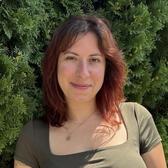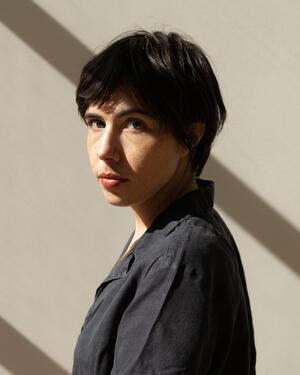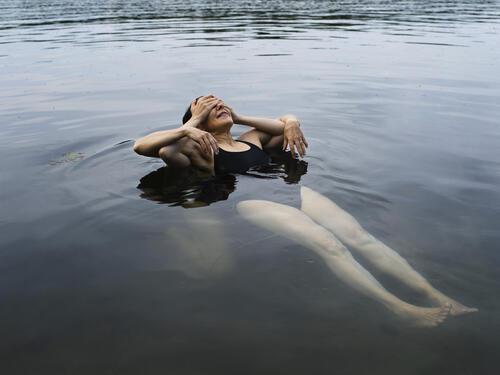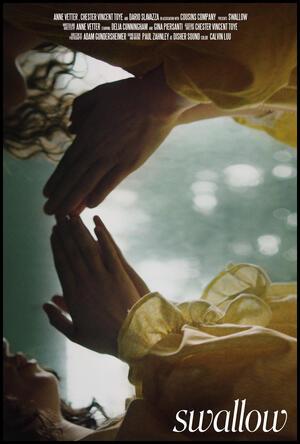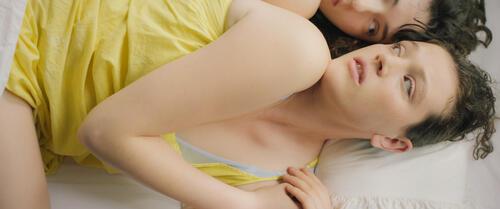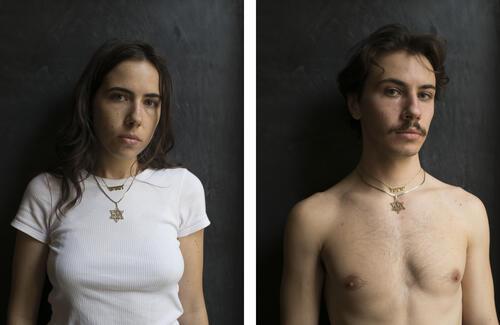7 Questions for Anne Vetter
JWA sat down with photographer Anne Vetter, a queer, non-binary Jew whose work explores play, family systems, performance, and the fluidity of identity. Anne’s film, Swallow, was recently featured as part of Havurah’s Jewish Short Film Festival, and they photograph and write for magazines and newspapers such as the New York Times Magazine, The Atlantic, the Washington Post, and the Washington Post Magazine.
JWA: Your work explores themes of gender and Jewish identity in such a playful way, often centering familial relationships. How did you first become interested in these concepts?
Anne Vetter: My family is very playful and very expressive and very silly. Play is the first language I learned to express myself through. Even now, I find that I’ll create alter egos or little acts that allow me to express things I don’t know how to say yet.
I became interested in gender and Jewishness because I struggled with them. So it just made sense to me to play with them and bring that play into my work. Both Jewishness and gender almost beg to be played with. I know as Jews we are no strangers to using humor to make sense of ourselves and our worlds.
JWA: Your short film, Swallow, was just included in Havurah’s short film festival. Swallow similarly emulates the playfulness that is so central to your work in its depiction of a queer relationship. Can you tell us about how you chose to weave queerness and Jewishness throughout the film?
AV: I wanted Swallow to be very Jewish without ever actually stating that the characters are Jewish. The characters both have Hebrew names, wear matching chai necklaces, and count in Yiddish. There’s so many ways we weaved Jewishness through, but I will focus on the song in the film. It’s a Yiddish love song called “In Droystn iz Finster” (It’s Dark Outside). The version in Swallow is based off of a recording from the Ruth Rubin archive [Canadian-American vocalist and Yiddishist]. I found the song after we finished filming, but the lyrics lined up with the story of the film in an uncanny way. It opens and closes the film, but it’s also played on the radio at one point and hummed in another. It felt like this sweet, perfect thread.
I think the queerness in the film is both more and less overt—it builds. I pulled from my own memories of being in closeted relationships and how the connection is contingent on never actually calling it queer. The whole film is filled with queerness that they refuse to name; they’re making up excuses to touch and connect in increasingly intimate ways.
JWA: What does playfulness mean to you as a mode of exploring Jewish and queer identities in the film?
AV: The whole film is essentially centered on a game of ten rules that one of the characters, Maytal, began making for her and the other character, Nomi, as a child. The film follows them as adults, following the rules again. As someone who was never very sporty myself, I am fascinated by how rules actually make sports more fun. You have to have something to respond to. You have to have something to play with. The rules act as a boundary around the characters. The rules give them permission to play and use play to express things they wouldn’t usually be able to express.
I also think the whole idea of rules is very Jewish. I mean, Judaism is a series of rules of how to live a life well. We came up with all of these rules and now we love arguing about them. That really doesn’t show up in the film as much, but we had a lot of fun talking about it on the (overwhelmingly Jewish) set.
JWA: Yellow is a recurring theme in the film. What was the inspiration behind this choice?
AV: Yellow came from a sonic/aesthetic place first. The first rule Maytal makes is that inside the house, the girls can wear “only dresses, only yellow dresses”. I come from an anthropology background and I know that changing clothing, site-specific clothing in particular, changes what feels or becomes possible. I knew the costumes in the film would take on a very important role. I didn’t want pink, blue, or purple because they felt a little too But I’m a Cheerleader (which is certainly not a bad thing); red felt too charged; and green and orange just didn’t fit into the poetry of “only dresses, only ____ dresses.” Yellow won.
JWA: You also just opened a show titled Love is Not the Last Room at Wright State University. This show examines the tension between privilege and marginalization. Could you share a bit about how that plays out visually?
AV: Love is Not the Last Room is a project made in collaboration with my family—my parents, my brothers, and my partner. It explores queer familial relationships, and uses my own gender fluidity as a lens to examine the gendered experiences of my family members.
I think artists are expected to explore our marginalized identities because, in a world that centers whiteness/maleness/cisness/Christianity/etc, we are seen as different. There’s also a genuine desire to bring voices that have been sidelined into the conversation, but when we are invited in there’s this expectation that our work will be about our marginalized identities.
I am exploring being queer and gender fluid and Jewish, but all of that exploration is happening in this quiet, large, safe space. I can’t separate out wealth and whiteness and being able-bodied from being queer and gender fluid and Jewish. It’s all there together in the image.
On top of that, I am examining everyone else’s gender as deeply as I am examining mine. So, you’ll have a portrait of my father who is a cisgender man and a WASP and he’s just taking up space in such a different way than I am, and even such a different way than my Jewish brothers are even though they share almost all of the same identities.
JWA: I really love the parallel images of you and your brother, Douglas, dressed the same and holding the same pose. Knowing your work, this really encapsulates how you use familial connections to explore gender. How has creating art with your family helped you understand your own gender?
AV: Photography has always been a tool I’ve used to see myself clearly. Even though it feels counterintuitive, I make self portraits on days that I am feeling dysphoric. Photography allows you to bend physical truth into new visual realities. I am more fluid in photographs than I may ever be in person. I do this, sometimes, through using my brother Douglas as a stand-in for me. We’re the same height and have nearly the same face, but he is a cisgender man. By using Douglas to represent myself, I get to exist in two bodies at once within the work, which actually feels truer to how I see myself.
My gender is so internal and constantly changing and can feel almost impossible to explain. But by bringing in my family as collaborators on this project that focuses on gender and gendered experiences, I’ve had to find ways to put words to what feels wordless. I’ve had to find ways to invite them in and explain the work so that they can exist fully in it as well.
JWA: What has been inspiring you recently?
AV: I am having a moment with clowns. About two years ago, I started meeting queer Jewish clowns in random places and didn’t think much of it. Then, clowns just kept popping up in my research and life and now I am just leaning into it. I love the absurdity, the repetition, the responsiveness, the unhingedness. I sometimes struggle with my work being too exact and tight and stiff. I am both starting to work with clowns in my photos and also trying to approach photography like an act of clowning. I don’t want to be so serious! I want to play more again!

